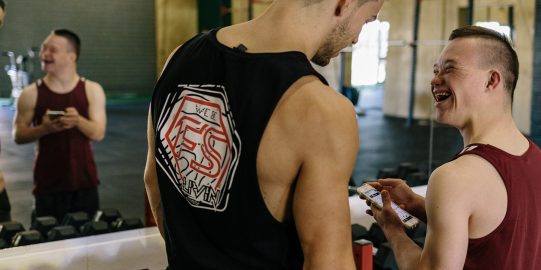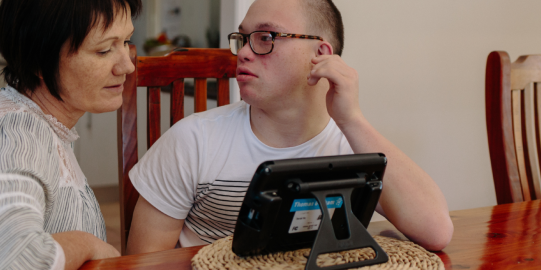The AAC users we interviewed shared ten specific strategies or insights that seem the most universal.
1. Good communication partners respect the effort AAC takes
For most people, AAC is more demanding than speech. (A minority of AAC users find speech more difficult than AAC.) Using AAC is labor-intensive. When we speak the words of our first language, we usually think only about the idea we want to express. The individual words just “come out.” Using AAC requires far more conscious effort than unimpaired speech. Each individual word has to be generated. For some AAC users, the motor coordination to select or compose a single word is a massive effort. Good communication partners respect this effort. They show their respect by accepting communication in whatever form or combination the AAC user selects: gestures, vocalizations, facial expressions, AAC, and more.
2. Good communication partners are patient and wait
AAC takes more time. A lot more time. The average person speaks 2-3 words per second, or between 150-170 words per minute. An expert typist can produce 75 words per minute, but the average person can type fewer than 40. Most of us can only type one-quarter as fast as we can speak. Most AAC users are not producing messages in ideal typing environments, and many have additional challenges that slow their speed of production. Some AAC users, like some speaking people, need additional time to consider what they want to say. The average AAC user can produce about 15 words per minute. Good communication partners are patient listeners. After they greet the AAC user or ask a question, they wait as long as necessary to hear the response. A common message we heard was “give me time and space so I don't feel rushed.”
3. Good communication partners help manage noise
AAC affects how we experience noise. Most AAC systems that generate speech have a limited range of volume. Volume on an AAC device cannot fluctuate as easily as speech, which can range from a whisper to a shout in the same sentence. A noisy cafe, work space, or classroom can drown out the AAC volume. In addition, many AAC users told us they are extra sensitive to background noise. They struggle to process speech in loud environments. Good communication partners help manage noise. This might include taking a conversation into a different room or selecting a different cafe to meet for lunch. It might mean moving a conversation from real-time to having it by email, instant message, or on social media. This could level the playing field if both communication partners are typing or using AAC.
4. Good communication partners help manage physical space
AAC changes how we experience physical space. Bright sunlight can make it difficult to view the device screen. AAC users may require regular access to electrical outlets to charge the device. The table or desk might need to be larger, to hold the usual laptop or meal, plus an AAC device. The AAC user may require extra room to type or select icons. Standing while using AAC can be more difficult than standing and talking if the device needs to be supported. Many AAC users have additional access needs, such as wheelchairs or medical devices. Some may find it difficult to even leave the house. Good communication partners try to find the spaces that are the most accessible to the AAC user.
5. Good communication partners watch the person, not the device
AAC changes the timing of messages and how messages are delivered. For example, an AAC user might contribute to a conversation by touching the screen of their iPad. They might construct the message, then activate speech, so that their message plays in the next moment. Speech is simultaneous with thought for speaking people, but there is a delay for the AAC user because they are speaking with or through a machine. The AAC user then has to activate facial expressions as their message plays, rather than their expressions naturally being simultaneous with their speech. Good communication partners learn how important it is to watch the AAC user’s face rather than their device while the message plays. They learn to allow for these changes in the timing of messages.
6. Good communication partners pay attention to the message and other cues
AAC (like all printed messages) is more easily misunderstood than speech. With speech, many of us can easily convey sarcasm, questions, humour, and irritation. Our tone of voice and rate of speech changes when we express an opinion versus make a flippant remark. We emphasize key words to convey meaning. The three words, “You like that”, can shift from a simple remark, to a question, to a statement of disbelief or horror, just by emphasizing a different word and shifting the tone. Digital voices are much less flexible. Good communication partners are attentive and observant. Rather than jumping to conclusions about what a person means to say, they look for different cues. They actively consider different meanings, and ask clarifying questions if needed.
7. Good communication partners do not dominate the conversation
AAC changes the routine of conversation. Conversation is a dialogue between two or more people. It is constructed together. It is not an interrogation, with one person asking questions while the other person responds. It is not a monologue, where one person just observes and listens. Speaking people usually have the advantage in conversations with AAC users. It is easy for a speaking person to dominate a conversation, such as swiftly changing subjects while the AAC user is still generating a message. Good communication partners actively try to level the playing field. They seek ways to explicitly pass control of the conversation to the AAC user. They also allow time for the AAC user to take their turn in the conversation.
8. Good communication partners respect an AAC user’s voice
Using AAC is deeply personal, the same way that our voices are deeply personal. Our voices are a reflection of our identity. They can reflect our age and cultural background, how we express our gender, how we were educated and where we live. We would expect an American teenager to sound very different from a Dutch child or an Australian retiree. Shaping our voice is a key part of how we express our identity. There are many more options today for the voices used in AAC, but we still lack digital voices for most regional accents and across a range of identities. AAC users need more people to advocate for more voice options. The design of an AAC device is often impersonal. It is a machine. Some use digital voices, while some use the recorded voice of other people. Imagine being a teenager who sometimes speaks with your mother's voice, other times with your sister's voice, and sometimes with your teacher’s? Some AAC users may be reluctant to adopt the AAC device as an extension of their own voice. They may need to spend a lot of time ensuring that the voice and the words truly reflect them as a person. Good communication partners learn how the AAC user feels about their voice and respects those feelings and limitations.
9. Good communication partners ask
AAC can become an extension of an AAC user’s voice. They may find it invasive if other people try to touch or use their AAC.One AAC user compared this to someone opening your mouth and trying to dig around in your vocal chords! The individual vocabulary, pre-programmed messages, and the history stored in the device, may all be deeply personal. Good communication partners will ask before trying to look at, touch, or use an AAC users device. Some AAC users may prefer you use your own device rather than touch theirs.
10. Good communication partners accept that communication is on the AAC users terms
AAC is a revolutionary and transformative technology. It can move someone from isolation and powerlessness, to connection and autonomy. It can also be very limiting and imperfect. The best AAC is rarely as expressive, flexible, or individual as speech. AAC users may have a love-hate relationship with their technology. Some are afraid to become dependent on it, because they fear what happens if their AAC is taken away, broken, or not available. Good communication partners do not impose their own feelings about how the AAC user “should” feel about their technology. They do not insist the person use their AAC, or not use it. Instead, good communication partners are so interested in what the AAC user has to say that they accept all communication, however it is expressed and however long it takes to convey.
“My partner is my favorite person to communicate with. He’s very understanding and I never feel judged by him. If I’m using speech and begin to struggle he will prompt me to get my iPad out (I often forget). He waits for me to type or find symbols in Proloquo2Go.
He is completely understanding of how I may switch back and forth between AAC and verbal speech. It doesn’t faze him or make him value one form of communication more than the other.
He values me communicating, however that may be. He listens.”
~ Oliver Waite, AAC user






